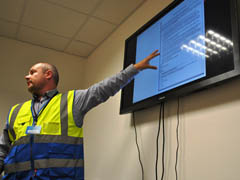For those overseeing security training compliance of employees, there are a few things you must know at any given time. Don’t be caught off guard when an auditor inspects your facility and training records.
Make sure you understand these five key pieces of information related to your compliance training program. It will prepare you when a compliance audit is conducted.
Read More
Topics:
Audit Preparation & Compliance,
Aviation Security,
Cargo Security
Most airports have numerous screening checkpoints situated in different areas of its facility. Passenger, cabin baggage, hold baggage, cargo, and non-passenger screening are typical checkpoints.
These airport checkpoints screen and process people, belongings, and cargo nonstop to prevent the entry of prohibited and dangerous items. Let’s briefly run through the different types of security screening checkpoints typically found at airports.
Read More
Topics:
Aviation Security,
Cargo Security,
Transportation
For security screeners, being able to identify threats and prohibited items under X-ray is an important responsibility. To aid in this task, some may agree that learning how to identify everyday objects is almost equally important since most items inspected are innocent. Think about it. How beneficial would it be for security screeners to recognize and clear innocent everyday items quickly and efficiently? A rapid check over of the X-ray image is all it would take for a skilled screener. That’s why practice recognizing everyday objects alongside threats and prohibited articles is encouraged.
Read More
Topics:
Security Training,
Aviation Security,
Training & Development,
General Security,
Cargo Security,
Ports & Borders,
Critical Infrastructure,
Transportation
Aviation is a complex industry that is constantly growing. According to IATA, over 3.7 billion passengers will fly this year. In a day, approximately 100,000 total flights take place and more than 16 billion USD worth of goods travel by air.
The global aviation industry is heavily relied upon by many and the demand for air travel will only grow. In fact, experts predict it will double over the next 20 years. That’s why security has and will always remain a top priority for those in aviation. So what types of challenges related to security does the industry face today?
Read More
Topics:
Aviation Security,
Trends,
Cargo Security,
Security Threats,
Transportation,
Current Events
We’ve said it before and we’ll say it again – Today’s X-ray systems are currently in their most stable form and they’ll be around for quite some time. The screening technology is reliable and has proven to be effective when used by trained X-ray operators for threat detection. Currently, there is no technology existing in the market to replace conventional X-ray in terms of cost and speed.
Manufacturers have even started to develop 3D imaging technology to integrate into their systems – thus extending the life of conventional X-ray further. This technology brings flat 2D X-ray images to life by giving them depth while providing a comprehensive overview of screened baggage and cargo for 3D image interpretation.
Read More
Topics:
Aviation Security,
Trends,
Cargo Security
X-ray systems are deployed at security checkpoints in many different industries. X-ray operators use them to screen belongings, mail, and cargo. In real-time, these operators must be able to view an X-ray image and promptly make a decision about it - whether the scanned items are safe to proceed or if further inspection is required.
To get to that point, there are a few fundamental topics X-ray operators must have a solid understanding of first. Help operators become successful at X-ray screening on the job by ensuring your X-ray equipment training includes these critical topics.
Read More
Topics:
Security Training,
Aviation Security,
Training & Development,
General Security,
Cargo Security,
Ports & Borders,
Critical Infrastructure,
Transportation
In the past few decades, terrorist tactics have changed. Whether or not you were aware, targets of terrorist organizations and lone wolf radicals have shifted.
Previous attacks and attempts had been aimed at airlines carrying cargo and passengers. Lately though, targets have veered in a different direction – towards mass transit and critical infrastructure.
That’s not to say they’ve stopped targeting airlines altogether. We know terrorists are always looking for ways to exploit vulnerabilities.
Read More
Topics:
Aviation Security,
Trends,
Cargo Security,
Critical Infrastructure,
Security Threats
A lot of companies out there are regulated by government entities that conduct random audits of screening procedures and training records. These unannounced audits cause a great deal of stress on supervisors and managers involved in gathering last minute reports with hopes it’s enough to satisfy auditors and receive a passing grade.
Truth be told, there’s no way of knowing what elements auditors will inspect when they arrive, but that doesn’t mean you can’t be proactive to boost likelihood of success during an inspection. These training and administration best practices can apply to many aviation and cargo security training programs including:
- TSA Certified Cargo Screening Program (CCSP)
- TSA Aircraft Operator Standard Security Program (AOSSP)
- TSA Indirect Air Carrier Standard Security Program (IACSSP)
- TSA Full All-Cargo Aircraft Operator Standard Security Program (FACAOSSP)
- TSA Model Security Program (MSP)
- EU Air Cargo or Mail Carrier operating into the Union from a Third Country Airport (ACC3)
- EU Commission Regulation No. 185/2010
- UK Regulated Agent Air Cargo Security Training Programme
Read More
Topics:
Audit Preparation & Compliance,
Aviation Security,
Cargo Security
Workplace supervisors have day-to-day responsibilities they must attend to including overseeing employees, ensuring productivity is maintained, and reporting to management. Part of their duty involves coaching employees, but sometimes that role expands into a full-on trainer position.
Many companies experience this – supervisors are forced to take on additional responsibilities in order to provide employees with security training in compliance with regulations or programs such as EU 185/2010, AOSSP, IACSSP, FACAOSSP, MSP, or CCSP. When supervisors double as security trainers, they’re only fulfilling a short term role so supervisors generally do not get the guidance and support needed to be successful in delivering training.
Read More
Topics:
Security Training,
Aviation Security,
Training & Development,
General Security,
Cargo Security
It seems like over the past fifteen years, we’ve heard a lot about the Improvised Explosive Device, otherwise known as IED. An IED is a homemade or noncommercial explosive device used to cause pain and mass destruction. It has been a prominent threat tactic used largely by terrorists in package, suicide, car, and roadside bombs to target both soldiers and civilians.
Despite recent media spotlight on these IED attacks in the past few decades, you might be surprised to learn these were originally devised over a century ago. Since then, the terminology has changed and the device itself has evolved, but the core concept of the Improvise Explosive Device remains the same.
Read More
Topics:
Aviation Security,
General Security,
Cargo Security,
Ports & Borders,
Critical Infrastructure,
Security Threats,
Transportation










